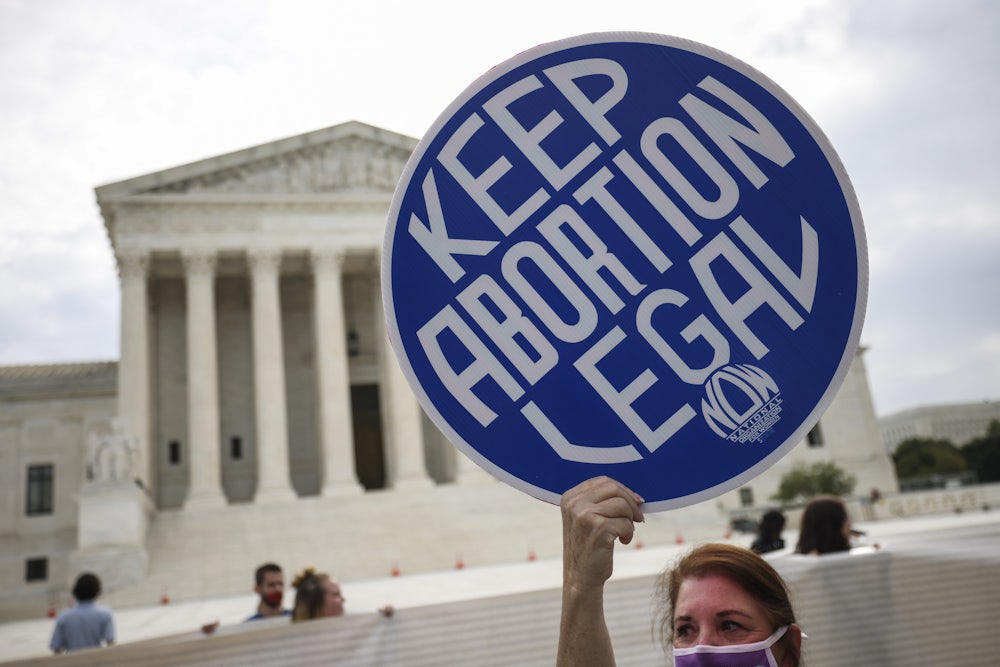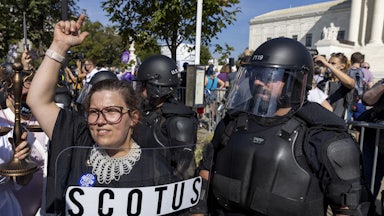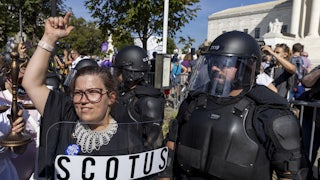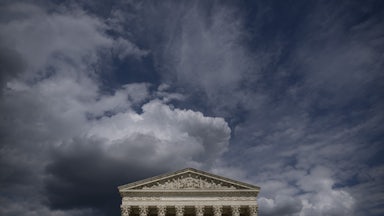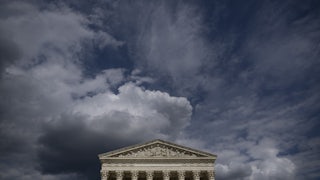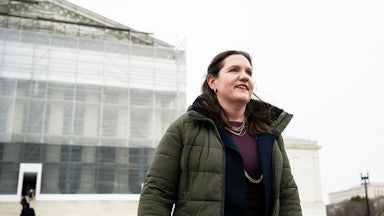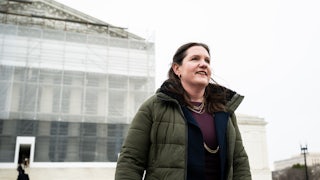The Supreme Court is setting up a blockbuster series of rulings on the future of abortion rights in America. On Friday, the justices turned down a second request to temporarily block Texas’s de facto ban on most abortions, allowing the controversial S.B. 8 to stay in force while litigation unfolds. At the same time, the court used a rare procedural maneuver to fast-track two legal challenges to S.B. 8 for consideration on November 1—one month before it will also hear oral arguments on a pre-viability abortion ban in Mississippi.
Justice Sonia Sotomayor, writing in a dissent from the court’s refusal to temporarily block S.B. 8, said she agreed with the court’s decision to take up the two cases. But she also called the procedural outcome “cold comfort” to the Texas women who would be affected by the law while the justices deliberate. “These women will suffer personal harm from delaying their medical care, and as their pregnancies progress, they may even be unable to obtain abortion care altogether,” Sotomayor wrote.
In a brief series of orders, the court said it would grant certiorari before judgment to two S.B. 8-related cases: the Justice Department’s challenge to the law in United States v. Texas, and a lawsuit brought against a variety of state officials by Texas abortion providers in Whole Woman’s Health v. Jackson. Most federal lawsuits that reach the Supreme Court are first heard by a federal district court and then reviewed by one of the federal circuit courts of appeals. But in exceptional circumstances, the high court can bypass the appellate courts and agree to directly review a district court’s ruling.
Certiorari before judgment is usually reserved for time-sensitive cases of national or international importance, such as Harry Truman’s order to seize steel mills during the Korean War or Richard Nixon’s resistance to a subpoena for White House tapes during Watergate. It can also be used in a more administrative fashion to accelerate similar cases at different stages in the appellate process so they can be heard by the justices together. The court’s decision to schedule oral argument in the S.B. 8 cases appears to be more administrative in nature, though it still carries a strong tinge of urgency. Friday’s orders require the parties to file briefs and hold oral arguments in just ten days—the court’s most accelerated schedule since Bush v. Gore.
In filings earlier this week, the Justice Department had asked the justices to issue an injunction that would temporarily block S.B. 8 from going into effect. Judge Robert Pitman, who heard the case at the district court level, issued such an injunction after ruling that S.B. 8 was unconstitutional earlier this month. But a conservative three-judge panel in the Fifth Circuit Court of Appeals blocked Pitman’s order soon thereafter and allowed S.B. 8 to go back into effect. The Supreme Court’s decision to not reverse the Fifth Circuit ensures that S.B. 8 will remain in force in Texas unless the justices decide to strike it down later this term.
That outcome is a vindication of the anti-abortion legal strategy that led to S.B. 8’s enactment in the first place. Many abortion-related cases previously reached the court through Section 1983, a Reconstruction-era federal provision that allows people to sue state and local officials in federal court for violating their federal constitutional rights. Since the Supreme Court has not yet overturned Roe v. Wade or Planned Parenthood v. Casey, federal courts would usually agree to block new state-level restrictions while a Section 1983 lawsuit challenging the restrictions worked its way through the courts.
S.B. 8, however, sought to prevent the federal courts from reviewing it altogether. It enacted a six-week abortion ban and then explicitly banned state and local officials in Texas from enforcing it. Instead, state lawmakers outsourced enforcement of the law to private citizens by permitting them bring civil lawsuits against people suspected of performing or assisting with an abortion. Those who successfully bring the lawsuit can receive damages of at least $10,000 or more—a bounty of sorts to encourage the general public to bring cases in the first place.
The Supreme Court limited the question it will decide in U.S. v. Texas to whether the federal government can seek injunctions in federal courts to block S.B. 8 and similarly evasive laws from being enforced. In its filings, the Justice Department argued that Texas had violated the Constitution’s Supremacy Clause by structuring S.B. 8 in such a way as to intentionally evade judicial review of the law’s impact on abortion rights in the state. “Texas has, in short, successfully nullified this court’s decisions within its borders,” the Justice Department told the justices.
Texas, for its part, did not really dispute the Justice Department’s claims of evasiveness. It simply asked to be rewarded for its clever attempt, again raising a host of procedural arguments for why the Justice Department can’t sue the state to block S.B. 8, either. “Texas executive officials do not enforce SB 8, and Texas’s judicial branch is not adverse to litigants who appear before it and who believe SB 8 is unconstitutional,” the state argued. “As there is therefore no state executive or judicial official who can be enjoined, there is no Article III case or controversy in which a federal court may enter an injunction.”
At the same time, in Whole Woman’s Health v. Jackson, the justices agreed to decide the case on the merits of whether a state can structure a law like S.B. 8 at all. The clinic framed the Texas law as an unprecedented act of defiance to the Supreme Court’s authority. “Had a state after Brown v. Board of Education enacted a similar law authorizing private citizens to sue anyone integrating a school, there can be little question that this Court would have immediately stopped that act of lawlessness,” the providers told the court. “That S.B. 8 seeks to frustrate the right to abortion rather than the right to equal protection cannot justify different treatment.”
The Supreme Court does not release vote totals for its decisions on emergency motions or for when it decides to hear cases. It takes only four votes for the justices to agree to hear a case, thus ensuring that a minority of justices can still influence the docket. But it takes at least five votes for the court to grant a litigant’s motion when it’s considered by the full court. Four of the justices—Chief Justice John Roberts, Justices Stephen Breyer and Elena Kagan, and Sotomayor—indicated in a September order that they would have voted to block S.B. 8 from going into effect.
Will the Supreme Court ultimately uphold S.B. 8 on the merits? Five of the justices—every conservative but Roberts—actively voted to keep it in force over the last two months. The justices’ votes on stays and injunctions aren’t always indicative of how they might rule on the merits, but in this case, the two issues are so closely intertwined that it feels impossible to differentiate them. At the same time, the court explicitly rejected a request from Texas in U.S. v. Texas to use that case as a vehicle to consider whether Roe and Casey should be overturned outright. Granting it would have allowed the justices to hear that question a month sooner than it had already planned.
That decision should not give abortion-rights proponents much cause for optimism. Legal observers almost unanimously expect that the Supreme Court’s conservative majority will sharply curb abortion rights—if not overturn Roe and Casey altogether—after it hears Whole Woman’s Health v. Dobbs in December. It’s possible that the justices will hand down a ruling that superficially appears to be an act of moderation: overturning Roe and Casey in Dobbs to give anti-abortion groups their long-sought victory while striking down S.B. 8 in Jackson for defying the Supreme Court’s authority. After Friday’s order, the era of legal abortion now appears to be over in Texas, and a large swath of the country could soon join it.
